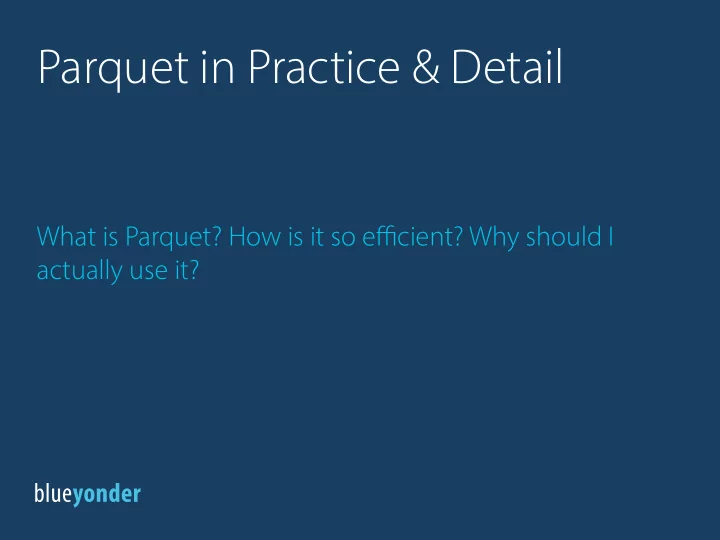

Parquet in Practice & Detail What is Parquet? How is it so e ffi cient? Why should I actually use it?
About me • Data Scientist at Blue Yonder (@BlueYonderTech) • Committer to Apache {Arrow, Parquet} • Work in Python, Cython, C++11 and SQL xhochy uwe@apache.org
Agenda Origin and Use Case Parquet under the bonnet Python & C++ The Community and its neighbours
About Parquet 1. Columnar on-disk storage format 2. Started in fall 2012 by Cloudera & Twitter 3. July 2013: 1.0 release 4. top-level Apache project 5. Fall 2016: Python & C++ support 6. State of the art format in the Hadoop ecosystem • often used as the default I/O option
Why use Parquet? 1. Columnar format —> vectorized operations 2. E ffi cient encodings and compressions —> small size without the need for a fat CPU 3. Query push-down —> bring computation to the I/O layer 4. Language independent format —> libs in Java / Scala / C++ / Python /…
Who uses Parquet? • Query Engines • Frameworks Hive Spark • • Impala MapReduce • • Drill … • • • Pandas Presto • … •
Nested data More than a fm at table! • Structure borrowed from Dremel paper • https://blog.twitter.com/2013/dremel-made-simple-with-parquet • Columns: Document docid links.backward DocId Links Name links.forward Backward Forward Language Url name.language.code name.language.country Code Country name.url
Why columnar? 2D Table row layout columnar layout
File Structure File RowGroup Column Chunks Page Statistics
Encodings • Know the data • Exploit the knowledge • Cheaper than universal compression • Example dataset: NYC TLC Trip Record data for January 2016 • 1629 MiB as CSV • columns: bool(1), datetime(2), fm oat(12), int(4) • Source: http://www.nyc.gov/html/tlc/html/about/ • trip_record_data.shtml
Encodings — PLAIN • Simply write the binary representation to disk • Simple to read & write • Performance limited by I/O throughput • —> 1499 MiB
Encodings — RLE & Bit Packing • bit-packing: only use the necessary bit • R un L ength E ncoding : 378 times „12“ • h ybrid: dynamically choose the best • Used for De fj nition & Repetition levels
Encodings — Dictionary • PLAIN_DICTIONARY / RLE_DICTIONARY • every value is assigned a code • Dictionary: store a map of code —> value • Data: store only codes, use RLE on that • —> 329 MiB (22%)
Compression 1. Shrink data size independent of its content 2. More CPU intensive than encoding 3. encoding+compression performs better than compression alone with less CPU cost 4. LZO, Snappy, GZIP, Brotli —> If in doubt: use Snappy 5. GZIP: 174 MiB (11%) Snappy: 216 MiB (14 %)
https://github.com/apache/parquet-mr/pull/384
Query pushdown 1. Only load used data 1. skip columns that are not needed 2. skip (chunks of) rows that not relevant 2. saves I/O load as the data is not transferred 3. saves CPU as the data is not decoded
Competitors (Python) • HDF5 • binary (with schema) • fast, just not with strings • not a fj rst-class citizen in the Hadoop ecosystem • msgpack • fast but unstable • CSV • The universal standard. • row-based • schema-less
C++ 1. General purpose read & write of Parquet • data structure independent • pluggable interfaces (allocator, I/O, …) 2. Routines to read into speci fj c data structures • Apache Arrow • …
Use Parquet in Python https://pyarrow.readthedocs.io/en/latest/install.html#building-from-source
Get involved! 1. Mailinglist: dev@parquet.apache.org 2. Website: https://parquet.apache.org/ 3. Or directly start contributing by grabbing an issue on https://issues.apache.org/jira/browse/PARQUET 4. Slack: https://parquet-slack-invite.herokuapp.com/
Questions?! We’re hiring!
Recommend
More recommend